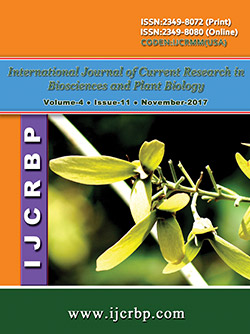 |
Online ISSN : 2349-8080 Issues : 12 per year Publisher : Excellent Publishers Email : editorinchiefijcrbp@gmail.com |
2QCQA Cell, Indian Institute of Integrative Medicine, Jammu – 180 007, J & K, India
3PSPB Section, NABTD, Bhabha Atomic Research Centre, Mumbai - 400085, Maharashtra, India
4Department of Biotechnology, Vijayaraje Institute of Science and Management, Gwalior - 475001, M.P., India
The genetic polymorphism and chemo-typing of seven ecotypes of Stevia rebaudiana Bertoni collected from different geographical regions of India was investigated by RAPD and LC-MS analysis. Fifty random decamer primers were screened to amplify the genomic DNA from different accessions to check the genetic polymorphism. Of these, eighteen primers selected to generate RAPD finger printing revealed 117 bands, of which 78 (66.67%) were polymorphic. Dendrogram and cluster analysis were constructed based on the unweighted pair group method with arithmetic means (UPGMA). LC-MS based chemo-typing revealed high diversity in the stevioside content in the germplasm/ ecotypes. Data revealed that stevioside content varied greatly from 486 to 986 µg/g of tissue dry weight among the ecotypes with higher content in Himachal Pradesh(SR-HP) followed by Maharastra (SR-MH), Uttar Pradesh SR-UP), Andhra Pradesh (SR-AP now Telangana State), Jammu & Kashmir (SR-JK), Punjab (SR-PB) and Madhya Pradesh (SR-MP). Seven ecotypes were clustered into two major groups and stevioside content variation was linearly associated with these groups. The results suggested that there was a good correlation and association with the data obtained from genetic diversity and phytochemical analysis. Such bioprospecting based studies could be useful to select for superior ecotypes of Stevia rebaudiana.
